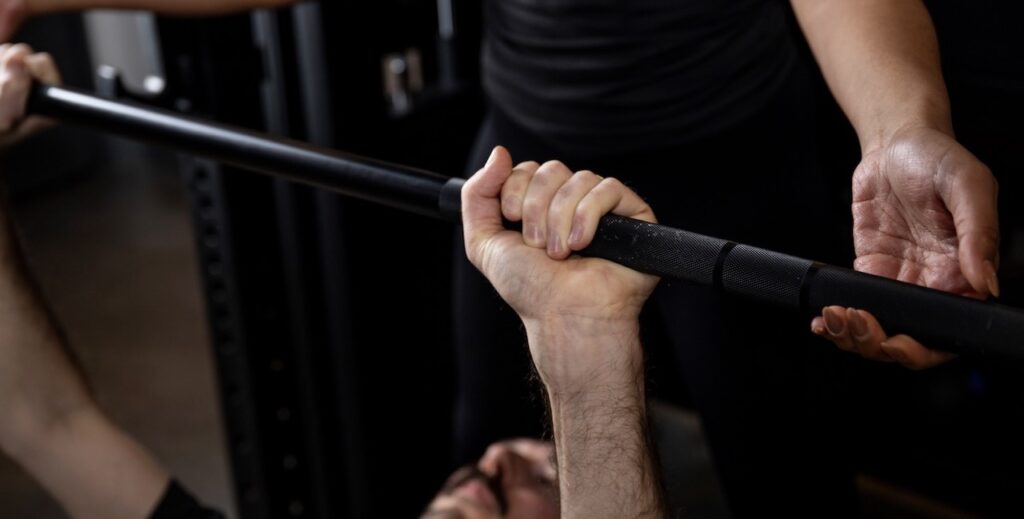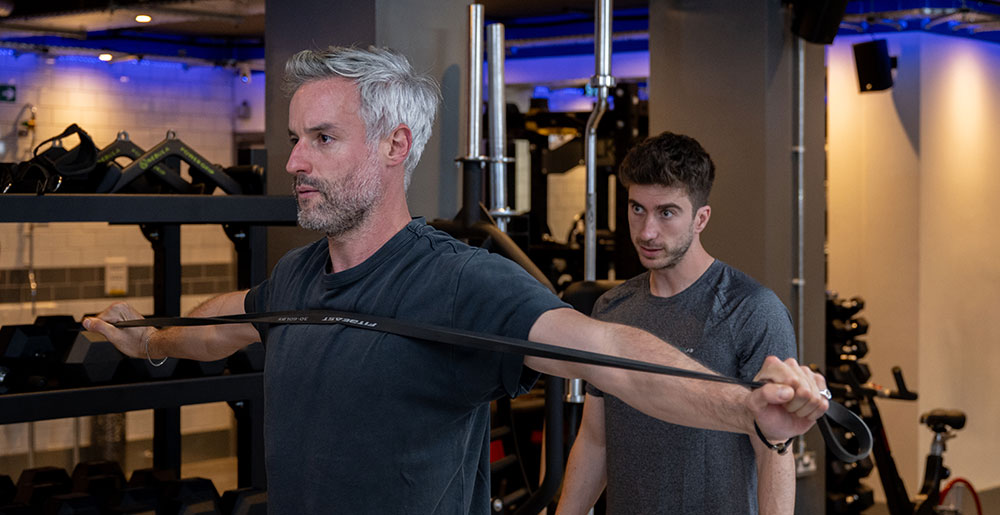If you’re thinking about improving your health and fitness, you’ll almost certainly be seeing terms like “strength training” and “resistance training”. In fact, they’re mentioned on virtually every page of our website here at Fitness Lab.
While terms like this are part of a personal trainer’s everyday language, this usually isn’t the case for people who are considering making some fitness changes. As such, this blog will take a more detailed look at what strength training actually is, how it compares to other types of exercise, and what’s involved with strength training.
As with all online information, this blog will give you a solid overview of the subject – but if you’d like more personalised information, you’re always welcome to book a consultation here at Fitness Lab. If you do, we’ll match you with a great team member here – and they’ll help you take a deeper dive into whether strength training could help you work towards the goal you have in mind.
Defining Strength Training
The term ‘strength training’ is used interchangeably with ‘resistance training’ and describes any exercise that uses resistance to challenge your muscles. That resistance can come from a range of places – weights, machines, resistance bands or body weight.

In short, the primary goal of resistance training is to build maximal strength and improve muscular endurance.
What Strength Training is Not
When people picture someone strong, they tend to imagine bulging muscles – but this isn’t really what strength training is about. When you train for strength, you’ll find that you get a more toned physique rather than significantly larger muscles.
People who are looking to add lots of muscle mass to their physique will train in a way that encourages “hypertrophy” – the biological way of describing enlarged muscle fibres. There are different ways of training in a gym or studio, depending on whether strength or hypertrophy is your goal – but we’ll touch on that a little more later.
Equally, strength training isn’t the same as cardio-based exercise, also known as “aerobic training”. Both are an important part of overall health – but cardio focuses on improving the performance of your heart and lungs during exercise, whereas strength training focuses on enhancing muscular performance.
Of course, none of these training methods are either right or wrong; they’re all perfectly valid ways of exercising. The key is to match the right method to the goal you have in mind.
Some Examples of Strength Training Exercises
At a glance, it can be tricky to work out exactly what’s being exercised when you see someone working out. However, the following types of exercise are typically used to focus on building strength:
- Weightlifting (barbells, dumbbells, kettlebells)
- Bodyweight exercises (push-ups, pull-ups, squats)
- Resistance band workouts
- Functional training (movements that mimic daily activities)
What Are the Key Benefits of Strength Training?
With virtually every passing day, more and more studies are carried out into the health benefits of strength training – and exceptional results are generally found across the board.
Although this is a huge subject, an overview of the key benefits of training for strength includes:
- Increased Muscle Mass – Helps build and maintain lean muscle mass.
- Enhanced Metabolism – A higher muscle mass raises your resting metabolism, boosting calorie burning even when you’re not working out.
- Stronger Bones – Improves bone density, reducing fracture risks.
- Joint Health and Mobility – Strengthens joints and connective tissue, preventing injuries.
- Hormonal Balance – Positively affects hormone production, including testosterone and growth hormones in men and the hormones that affect menstruation and menopause in women.
- Chronic Disease Prevention – Helps regulate blood pressure, cholesterol, and blood sugar levels.
Strength Training vs Other Types of Training
As we touched on earlier, strength training is based on different goals when compared to training for hypertrophy and even more so when compared to cardio training.

To understand the differences, it’s worth looking at how training for strength lines up next to these other types of exercise.
Building Muscle (Hypertrophy) vs. Building Strength: What’s the Difference?
If you see someone in the gym or studio lifting weights, you’d be entirely forgiven for thinking their goals are probably the same – but, depending on the type of exercise they’re doing, the weight they’re lifting, or even the speed their moving at, they could be training with different goals in mind.
To get a good understanding of the differences, it’s useful to actually see the differences side-by-side – so we’ve put this table together:
| Muscle Building (Hypertrophy) | Strength Training | |
| Goal | Increase muscle size | Maximise strength |
| Rep Range | 6-12 reps per set | 1-6 reps per set |
| Weight Used | Moderate to heavy (65-80% of max) | Heavy (80-95% of max) |
| Rest Periods | 30-90 seconds | 2-5 minutes |
| Outcome | Improved strength with a focus on larger, defined muscles | Improved maximal strength |
Now, there is a little crossover between these two disciplines. Lifting weights for hypertrophy will add some strength, just like lifting for strength will improve muscle tone – but, as mentioned, lifting for strength will result in a more lean physique longer-term, whereas lifting for hypertrophy will be more effective at adding size to your physique.
Strength Training vs. Cardio-Endurance Exercise: What’s the Difference?
While strength training and hypertrophy training both focus on the muscles, strength training and cardio training are more distinct. Cardio involves activities that elevate your heart rate and sustain it for extended periods. These workouts predominantly enhance cardiovascular endurance and respiratory efficiency.
Examples of cardio/aerobic training include:
- Walking and hiking
- Jogging and running
- Swimming
- Cycling
- High-Intensity Interval Training (HIIT)
Like strength training, cardio training has some stand-out health benefits, including:
- Improved heart and lung health
- Increased endurance and stamina
- Better oxygen utilisation (VO₂ max)
- Fat loss and calorie burn
- Improved insulin sensitivity
- Mental health improvements
While cardio is fantastic for heart and lung health, it doesn’t offer the same muscular and skeletal benefits as strength training. As such, a rounded exercise plan will typically include some elements of training muscles and some elements based on training your heart and lungs.
Do Strength Training and Cardio Work Against Each Other?
For a long time, it was believed that strength training and any exercise that improved cardio performance worked against one another, but this has been firmly disproven.
In fact, research tells us the opposite is true. Having a good level of cardio fitness actually improves the results you can expect from strength training. A solid aerobic base is proven to improve recovery rate – and that’s true in the very short-term (between your sets) and longer-term too – as you recover between workouts.

Interestingly, it works the other way around too. Studies show that runners’ (and other cardio-focused participants’) performance is improved with the addition of the right kind of strength training. This is because strength training enhances the nervous system’s ability to effectively recruit muscles, coordinate movement, and generate force most efficiently. When this is applied to the muscles responsible for propulsion and stabilisation in your chosen sport, you become a more efficient athlete overall – and less prone to injury.
So, with any idea that strength trainers shouldn’t do cardio and cardio-focused trainers should lift weight debunked, the question instead becomes about how to best combine the two so you see the results you’re looking for. This is where a great coach comes into their own – they’ll help look at precisely what your goals are and how to make your program work for you.
A Key Difference Between Cardio and Strength Training
A big difference between strength training and aerobic training is how much more the latter feels like hard work.
This is because cardio involves upping your heart rate for a sustained period and, put simply, getting out of breath. These are both parts of building endurance and efficiency in your heart and lungs. However, strength training is far less likely to leave you gasping for breath or looking for a bottle of water to wash the sweat from your eyes. As well as being a huge bonus for people who are going to the office after a studio visit, this is often a surprise for people who start strength training.

The truth is, when it comes to strength, the right technique (how you lift the weights) and a factor called “progressive overload” are much more significant factors than how sweaty you get.
Progressive overload is the term used to describe the process of adapting your workout to continue building and maintaining strength – and can include adding weight, varying sets and reps, altering the tempo of your workout, and even changing your rest period – making sure you’re constantly challenging your muscles in exactly the right way.
Is Strength Training Right for You?
When you come for a consultation at Fitness Lab, we’re not here to tell you what your goal should be. Instead, people usually have a goal in mind – whether that’s losing weight, improving their long-term health, building muscle, alleviating the symptoms of a health condition, or looking to improve their endurance.
We can help with all of those things – and more often than not, strength will have a part to play.
The benefits of improving your strength are nothing short of incredible – supporting sustainable weight loss, toning your body, improving bone density, enhancing mobility and joint health, improving hormone balance, and even showing a positive effect on numerous chronic health issues.
Ultimately though, the key part of any training program is consistency. For most people, the fact that these benefits can be realised in just a couple of sessions per week is a huge help with that consistency – and when you’ve got a great personal trainer adding world-class support while keeping things fresh and interesting – consistent strength training just ends up feeling like an enjoyable, indispensable part of your week.

